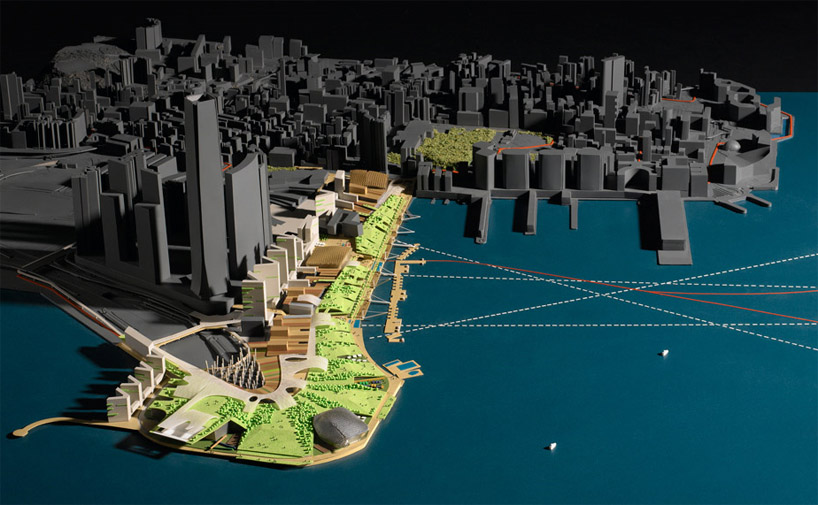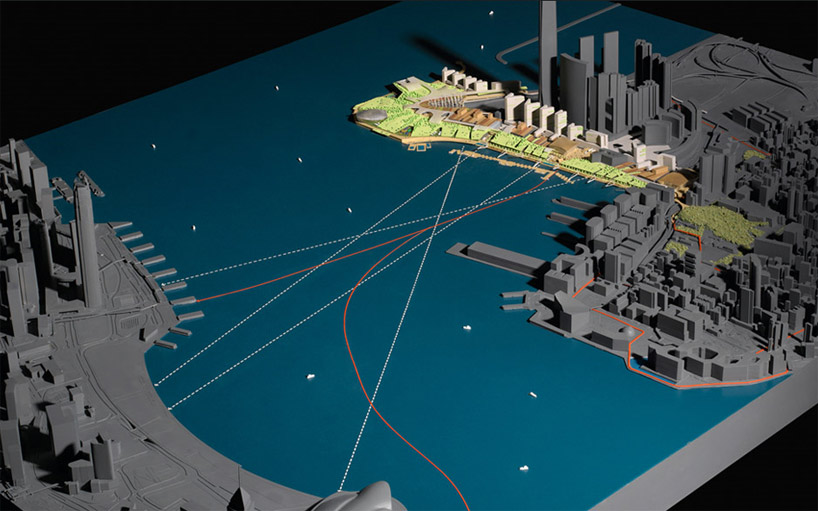
model of 'cultural connect' by rocco design
rocco design are one of three finalists who have unveiled their plan for the west kowloon
cultural district competing against OMA and foster + partners.
their plan 'cultural connect' is centred around multiple connectivity. WKCD breaks the isolation
by pedestrian, tram, rail, vehicular, bicycle and ferry links to and from different directions.
two footbridges above austin road connect with the elements and kowloon station. visitors
from the XRL station are greeted by the m+ forecourt, from where they disperse into the streets
and alleys of WKCD. towards the eastern end of the district edged upon canton road, a network
of pedestrian decks draw visitors from yaumatei, jordon, kowloon park and tsim sha tsui into
the district.
the district is also well-served by multiple public transportation systems including buses, taxis, ferries,
the XRL, the airport express and MTR. hopping onto a tram that runs from the star ferry pier to
the district along canton road would be a pleasant alternative. in addition, water taxis bring visitors
from tsim sha tsui, north point, central and wanchai directly to the heart of WKCD.
WKCD is also conveniently plugged into the public road network. multiple vehicular access points
are provided along the northern edge on austin road and number 3 expressway. major drop-off points
and parking facilities are conveniently located for all venues.
cycling is encouraged in WKCD with dedicated cycle track and cycles racks along the promenade.
the track is intended to be connected beyond wkcd to link up with a city-wide network in the future

cultural facilities
public creatives = public art + public design + public event + public engagement
'public creatives' is an initiative within an overall cultural
framework. the initiative aims to foster
opportunities for showcasing
our local artistic talents, complements audience-building and supports
art education. synergizing the artistic, functional and commercial
potentials of our visual art and creative
industries, it brings
together public art, public design and public event through various
forms of direct
public engagement. 'public creatives' and WKCD are
reciprocally beneficial to each other – WKCD
becomes the stage for
local artists while their works enrich the qualities of the urban
spaces in the district.
master layout plan
the master plan is organised in 3 layers from the city (north) to the
harbour (south), namely: the city link,
the cultural cover and the
green terrain.
in the city link, working from east (conton road) to west, there are
one block for workspaces, a residential
block, the headquarters for art
organisation or international cultural institutes, four more blocks for
residential,
a hotel block in front of the theatre square. across the
west cross harbour tunnel, next to the typhoon shelter
is another hotel, and then four more residential blocks in a row marking the
boundary of WKCD.
in the cultural core, working from east (canton road) to west, there is
the xiqu centre with the xiqu square to
its south. further to the west,
there is a medium-sized theatre, then the humanities centre, black box
theatre,
m+ and the central square. to the north of the central square
the m+ forecount lays adjacent to the xrl plaza.
to the south is the
music forecourt. to the west of the central square is the concert
hall/chamber music hall.
two black box theatres are further to the
west. the great theatre 1 and the theatre complex embracing the theater
square are located in front of the ICC. the children's museum and the
community art college are further west
bordering onto the harbour park. the
mega performance venue is located at the western end, marking the end
of the park.
in the green terrain, from east to west are the rde with their
accessible roof garden, the exhibition centre,
the promenade and the
filtration garden, then the music forecourt. a pier in the form of
pontoon is reached from
the music forecourt via a draw bridge. more
pontoons are on the water-edge for exhibitions, installations
and
performances. theatre steps are located to the south of the theatre
square. along the promenade further to
the west is the market place.
before reaching the market place, a swimming pool is floating in the
harbour next to
a slipway. form the market place, the great theatre 2
is on the harbour front with a pier for water taxi to its west.
embracing the great theatre on three sides is the harbour park. to the
northern end of the harbour park, the landscaped
roof of the mega
performance venue is turned into a public forum-the banyan forum, with
a suspended bridge-walk
over the harbour.

retail and dining
street-based retail shops energise the public realm with trades and festivities.
diverse dining outlets enjoy scenic harbour views and offerunique dining-performance ambience.
culture and entertainment
alongside with the shops and restaurants are a series
cultural/entertainment venues: pop culture centre,
martial art centre,
video/animation centre, culinary school...
city life
a 24-hour district for all people at all times with allkinds of
activities. artists and creative entrepreneurs
are encouraged to work
and live in the district.
3d public space
the master plan :
like a scroll, it entices one to explore and to discover;
does not solely glorify icons, but also celebrates streets/squares/gardens embedded in the urban fabric.
it includes: theatre steps, banyan forum, a suspended footbridge, a harbour park, a plaza for a black box
theatre, tramway, music forecourt, xiqu square, art-venue, alley, the promenade and market place.



green living
urban ecology
an ecology of utilization of renewable energy, reduction of resources consumption and adoption
of water and waste recycling.
urban oasis
over 40% of the site is designed as green space and green roofs to reduce urban heat island effect.
urban comfort
extensive greenery, traditional colonnades and arcades, and the
innovativeenvironmental shade are
all integrated to have a pleasant
environment.

rocco design states:
our hope…
synergy between cultural facilities and policies
cultural facilities and cultural policies are mutually dependant.
our design philosophy of cultural-connect is conceived to address four
major aspects of our cultural vision for WKCD.
the physical proposals
are an embodiment of functional adaptability, programmatic feasibility
and design practicality.
1.education
education is the foundation of culture. different educational
facilities are proposed at different locations within the plan,
such as
children’s museum, m+ resources and education programmes, community art
college, practice facilities of xiqu
centre, artists-in-residence
programmes.
our strategy aims to create a framework that caters for the needs of
all people covering high and popular arts, traditional
and avant-garde,
local and overseas. not only does it cater for cultural practitioners
but also the audience and the education
communities. the multi-level,
multi-layer institutions will groom local talents for the future to
come.
2.incubation
there are different accommodations reserved as incubators for cultural
practitioners in the plan, such as incubator centre,
wide range of
public, spaces and outdoor squares, experimental black box theatres,
flexible art spaces, multi-purpose
workspaces…
incubator programmes for up-and-coming cultural practitioners are
quintessential to harnessing the potentials of our
society’s artistic
talents in the long term.
3. exchange
hong kong is one of the world’s most open societies. we envisage wkcd
will be a regional platform for international
exchange, research,
assimilation and experimentation. convention facilities and
multi-purpose workspaces are located next
to the XRL station. they are
intended for art organisations and international cultural institutions.
community art college
and the artists-in-residence programmes will
promote exchange between local and overseas cultural practitioners.
4. governance
our design facilitates the participation of both local and overseas
management companies, independent and conglomerate
agencies, large and
small groups, who could potentially coexist in different permutations
of management styles. the venue
disposition concept allows the future
management in wkcd to be innovative and flexible.

the WKCD will establish that un-impeded cultural-urban field that ensures fluidity and connectivity.
connectivity between art forms, between life and culture, space and movement, inside and outside,
art and community, hong kong, south china and overseas.
"
No comments:
Post a Comment